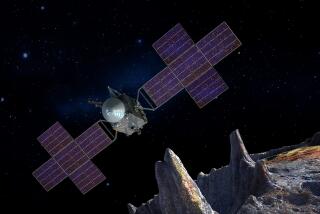InSight: NASA’s next mission to Mars will go deep beneath the red planet’s surface
- Share via
NASA has launched many groundbreaking missions to Mars, but its next mission will do so literally.
The Mars InSight lander, planned for launch May 5, will be the first spacecraft dedicated to studying the deep interior of the red planet. The discoveries it makes could unlock hidden secrets about the structure of Mars, how it evolved and how other rocky planets — including Earth — came to be.
“The goal of InSight is nothing less than to better understand the birth of the Earth, the birth of the planet that we live on, and we’re going to do that by going to Mars,” said Bruce Banerdt, InSight’s principal investigator at NASA’s Jet Propulsion Laboratory in La Cañada Flintridge.
Short for Interior Exploration using Seismic Investigations, Geodesy and Heat Transport, InSight will be the first spacecraft to land on a planet since Curiosity’s “Seven Minutes of Terror” on Mars in 2012. When it touches down Nov. 26 in a flat plain just north of the equator called Elysium Planitia, it will unfurl its solar arrays and deploy a set of instruments designed to interrogate the planet’s insides.
The lander will use its robotic arm to place a seismometer on the smooth surface. That seismometer will pick up the vibrations from marsquakes — seismic waves that have been modified by the different layers of material they have passed through. Those altered waves will allow scientists to determine what those layers of material are made of.
InSight will also hammer a heat-flow probe about 16 feet beneath the surface. The deeper the probe goes, the higher the temperature rises — and the researchers can use this to calculate how hot Mars’ deep interior really is.
The spacecraft’s third major experiment will measure the shift in radio signals between it and Earth to figure out how much Mars’ north pole wobbles over the course of a Martian year. The size and frequency of that wobble will reveal clues about the planet’s core, including its size and density.
Understanding Mars from within could help scientists better understand the evolution of other rocky planets, including Earth as well as exoplanets far beyond our solar system. That’s because the Earth’s interior experienced much more churning than Mars’ did, erasing crucial information about what its insides used to look like. Mars’ inner structure should more closely reflect that early stage of planetary evolution.
“How we get from a ball of featureless rock into a planet that may or may not support life is a key question in planetary science,” Banerdt said.
InSight will be the first interplanetary mission launched from the West Coast — and many Southern Californians will be able to look to the skies and briefly watch the spacecraft on its journey to Mars, said Tom Hoffman, InSight’s project manager at Jet Propulsion Laboratory.
“It should be spectacular,” Hoffman said.
The launch will be an early show, he added; it is scheduled for about 4 a.m.
Follow @aminawrite on Twitter for more science news and “like” Los Angeles Times Science & Health on Facebook.
MORE IN SCIENCE
NASA’s dangerous Juno mission: Unravel the mysteries of Jupiter and solve the mysteries of life
A hunt for dark matter in a former gold mine
For a 3-year-old boy, a risky operation may mean a chance to hear







